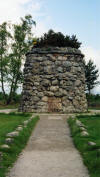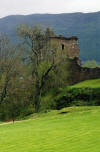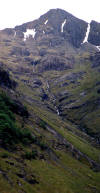|
Culloden Moor Four hundred years after Bannockburn, Bonnie Prince Charlie and his Highlanders fought the English, as well as their own countrymen, on the moor at Culloden. It was there that Prince Charlie lost all hope of gaining the throne of his Stewart ancestors.
without sleep, and had scarcely eaten in the same span of time. Then, what they didn't know before arriving was that the man who farmed there had built extensive turf dikes, which held the recent rains and turned the fields a boggy mess on which foot soldiers were at a distinct disadvantage. The English victory at Culloden was hardly one of which to boast, and their behavior afterward appalling. The English used their muskets as clubs to dash out the brains of the wounded and sprinkled one another with Scottish blood. Then, they sat and casually dined upon the field where the dead still lay.
After Culloden, everything about the Highland way of life was banned - the claymore, the bagpipe, and even the wearing of tartans. While one may lament the end of a way of life and abhor the brutality with which the Highlanders were treated, it was providential that they lost this, their last great battle for Scotland. Their would-be sovereign would have imposed on the entire nation a single religion. As it is, the ban on tartans was lifted in 1782, and in 1843 Queen Victoria appointed the first "personal piper to the Sovereign". Today, Scotland again has her own Parliament to govern domestic affairs, and some hope that one day the political battle for full Scottish independence may be won.
I returned
to the fields of glory, where the green grass an' flowers grow,
In the great
glen, they lie a-sleeping, where the cool waters gently flow,
See the tall
grass is there a-waving as their flags were so long ago;
March no more, my soldier laddie, there is peace where there once was war. Author Unknown The Great Loch Ness and Urquhart Castle From Culloden, we turned west into Inverness-shire, then south again, and drove along Loch Ness. The loch is described in one place as an "endless streak of grey" and not worth visiting. Ness is the largest of three lochs in the great glen of Urquhart, stretching for sixty miles, but the person who described it so demeaningly must never have seen it when the sun shone, nor visited the spots where its shoreline is loveliest. We do not recommend it for monster sighting but for its beauty and history.
Urquhart Castle
Urquhart Castle dates to the 13th century. It changed hands repeatedly and was controlled several times by MacDonald, Lord of the Isles. The Tower House, which is five stories high, was added in the sixteenth century as the lord’s private residence. Leaving Urquhart, we drove into stormy Highland weather ... Ben Nevis It rained for about ten minutes and suddenly stopped as we faced the highest peak in all of Britain. Ben Nevis stands at 4,409 feet. In comparison, the highest peak in America's Appalachians is 6,684 feet tall and the highest peak in the Rockies is 14,433 feet. While Ben Nevis is no giant among the world's mountains, it is an impressive sight among the Highlands of Scotland. The Nevis range in fact offers a number of distinctive scenes. This peak in the Nevis Range creates an impressive back yard to the home at its foot. Loch Linnhe, beneath it, creates an equally impressive front:
Glen Coe
The MacDonalds and the Campbells had been bitter enemies for two centuries when opportunity for revenge presented itself to the Campbells. After their defeat by King William, clan chiefs were offered pardons in exchange for oaths of allegiance. Delayed by winter weather and other circumstances, Alasdair, 12th Chief of the MacDonalds of Glen Coe, was five days late arriving at the place appointed for swearing allegiance. He was nonetheless allowed to take the oath. Returning home, he and his clan believed that all was well ...
Several weeks later, Captain Robert Campbell arrived at Glen Coe with two companies of soldiers and asked MacDonald for refuge from a winter storm. Shelter and food were given, and the soldiers remained for ten days. The Highland code of hospitality dictated that Campbell say and do no harm while sheltered beneath MacDonald’s roof. Yet, while he and his men remained at Glen Coe, they in fact were awaiting orders. When orders came, they rose in the night and set out to kill everyone – men, women, and children – under the age of 70. About 30 were slain while 300 fled to the hills. Many who escaped the sword died of cold and starvation.
The Three Sisters – Beinn Fhada, Gearr Aonach, and Aonach Dubh – stand as lonely sentinels on the west side of Glen Coe, guarding the graves of MacDonald, his sons, and others. Those who survived the slaughter faded into obscurity. MacDonald of Glen Coe is no more.
__________________________________________________________________________________________________
If you came from the Bed and Breakfasts page, If you came from a search, click here to begin at the beginning: Home
Copyright 2018 · Loretta Lynn Layman · The House of Lynn |
||||||||||||||||||||||||||






















